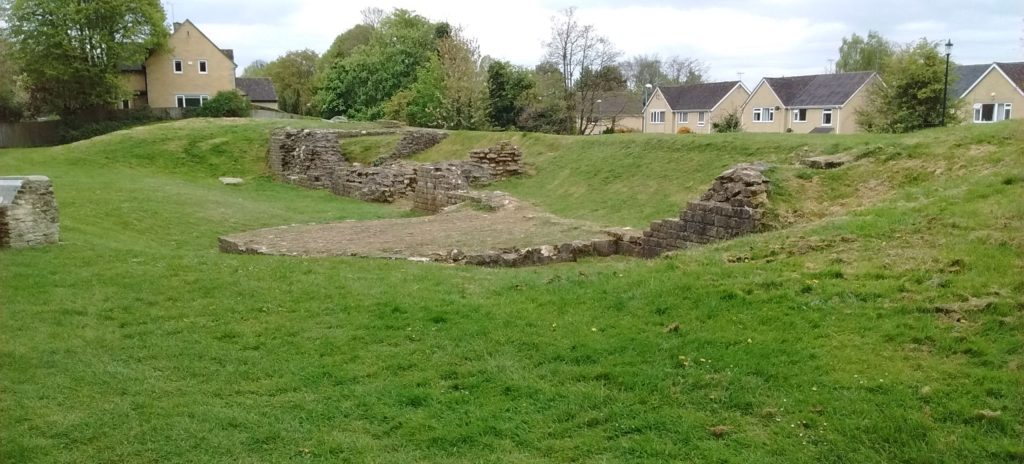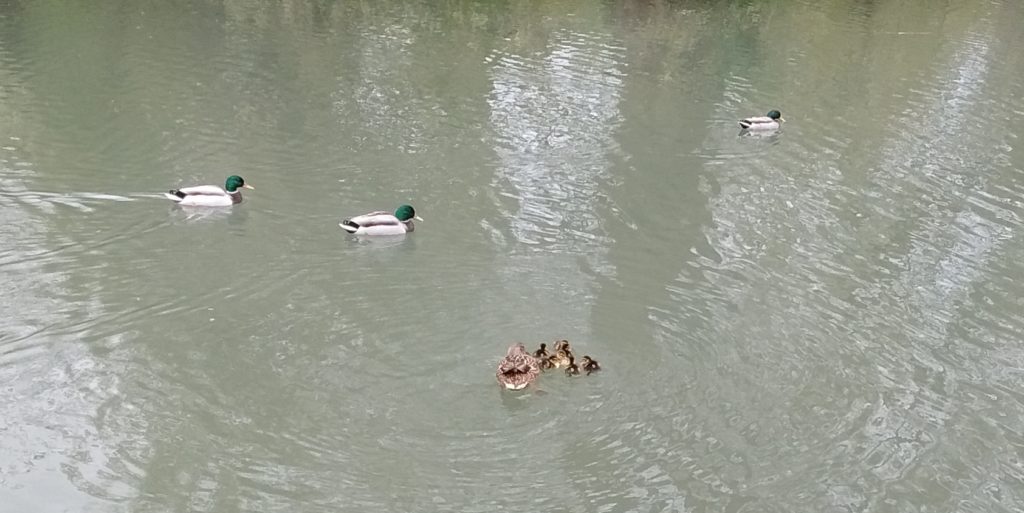With the kind support of a small grant from the UK Numismatic Trust, in April 2017 I was able to undertake the first of several research visits to study examples of Worcestershire tokens held in regional museums. My destination? The Corinium Museum, Cirencester!

Remains of the Roman city wall in Abbey Grounds Park, Cirencester
I must admit that this was a quite unexpected location to find myself on the hunt for seventeenth century tokens. Cirencester is best known as the site of Corinium Dobunnorum, the second largest town in Roman Britain; consequently, the Corinium Museum holds an absolutely exquisite collection of Roman material from the town and its hinterland, and rightly emphasises these finds in its public galleries. However, the museum also holds a decent post-Roman archaeological and numismatic collection, within which is presently included the archaeological collection of Reverend David Royce (1817-1902), a Rutland-born vicar and antiquary formerly based at Lower Swell near Stow-on-the-Wold, Gloucestershire. Donated to St Edward’s Hall, Stow-on-the-Wold, in 1902, Royce’s collection primarily consists of local finds acquired during his tenure in the Cotswolds, and preliminary work on this material was initiated by Leslie Grinsell in the mid-twentieth century and eventually published in the Transactions of the Bristol and Gloucestershire Archaeological Society in 1964. In this paper Grinsell noted that Royce ‘was for many years an ardent collector of 17th-century trade tokens of the Cotswolds and their surroundings’; for reasons of brevity, however, only the Gloucestershire component of this collection was published, leaving the character of its Worcestershire element frustratingly unclear. After a few emails and phonecalls I discovered that Royce’s archaeological collection had since been relocated to the Corinium Museum, and now formed the target of my visit; once all was arranged with the museum I hopped on the early train to Kemble to undertake the research.

Incidentally, I saw some really cute ducklings in a nearby pond…
The Worcestershire element of Royce’s token collection was small, consisting of four tokens only: three of Shipston on Stour, and one of Evesham. This mix seems quite consistent with the suggestion that these represent local finds discovered in the north Cotswolds; Evesham and Shipston are some of the southernmost Worcestershire towns whose denizens are known to have struck tokens during the seventeenth century, and both were connected to the area around Moreton-in-Marsh and Stow-on-the-Wold by major overland routes at this period.
All of the Worcestershire tokens housed in the Royce collection are private issues, produced on behalf of named individuals rather than civic institutions. The Evesham specimen was a 1649 farthing token of Peter Cross (Cotton 31a), and was in very crisp condition; it is quite likely that it had never entered the ground, and could well have been discovered between the floorboards of an old building prior to Royce acquiring it. The same could not be said for one of the Shipston on Stour specimens, a 1666 halfpenny token of Henry Cotterell (Cotton 60); this example is moderately corroded and rather worn, and probably was unearthed by the plough like so many of the other finds in Royce’s collection.
The last two tokens are undated farthing tokens of Edward Pittway (Cotton 62), each a die-duplicate of the other. Establishing the dating of such specimens is one of the main aims of the Worcestershire Token Project, and while a thorough treatment of this topic must await the results of the completed die study, the borders surrounding the inscription and central designs give some clues. Early work on seventeenth century Oxfordshire tokens by John Milne has provided a standard classification for border types, and his research – and subsequent work on other county series by George Berry, Peter Preston-Morley, and George Pegg, among others – has demonstrated that border types have a broad correspondence with issue dates. All the specimens of this type that I’ve seen combine cable pattern inner borders with outer borders composed of ‘oblong labels’, a combination that occurs on tokens of other counties in the period 1648-c.1664.
What about the faces behind the objects? As always, our first clues are stamped across the tokens themselves. Edward Pittway’s tokens bear the Ironmongers Arms, while those of Henry Cotterell bear the Mercers Arms, indicating the trades of their issuers. Peter Cross’ token, however, bears no such information, and we are forced to delve a little deeper into the historical record. The seventeenth century Evesham Borough Books, meticulously edited by Stephen Roberts and published by the Worcestershire Historical Society, confirm that Cross was a man of some local standing. He was elected as assistant to the town council on 30 March 1649, and held that role as late as 1665. Cross died in the summer of 1667, and his burial is recorded in the parish register of Evesham All Saints under 16 July 1667; by the end of the following month he had been replaced in his civic post by one Thomas Bartlett. The design of Cross’ token adopts the common motif of a triangle of initials representing his own name and that of his wife, whose forename is recorded only as the letter ‘M’; consultation of the parish register of Evesham All Saints confirms her maiden name as Mary Baseley, the couple having wed on 7 October 1638. Future research will add much more flesh to these bones!
Many thanks to all the staff at the Corinium Museum, Nigel Surman (Stow and District Civic Society), and the UK Numismatic Trust for generously sharing information, granting access to the Royce collection, and generally making this trip possible!
Murray Andrews
